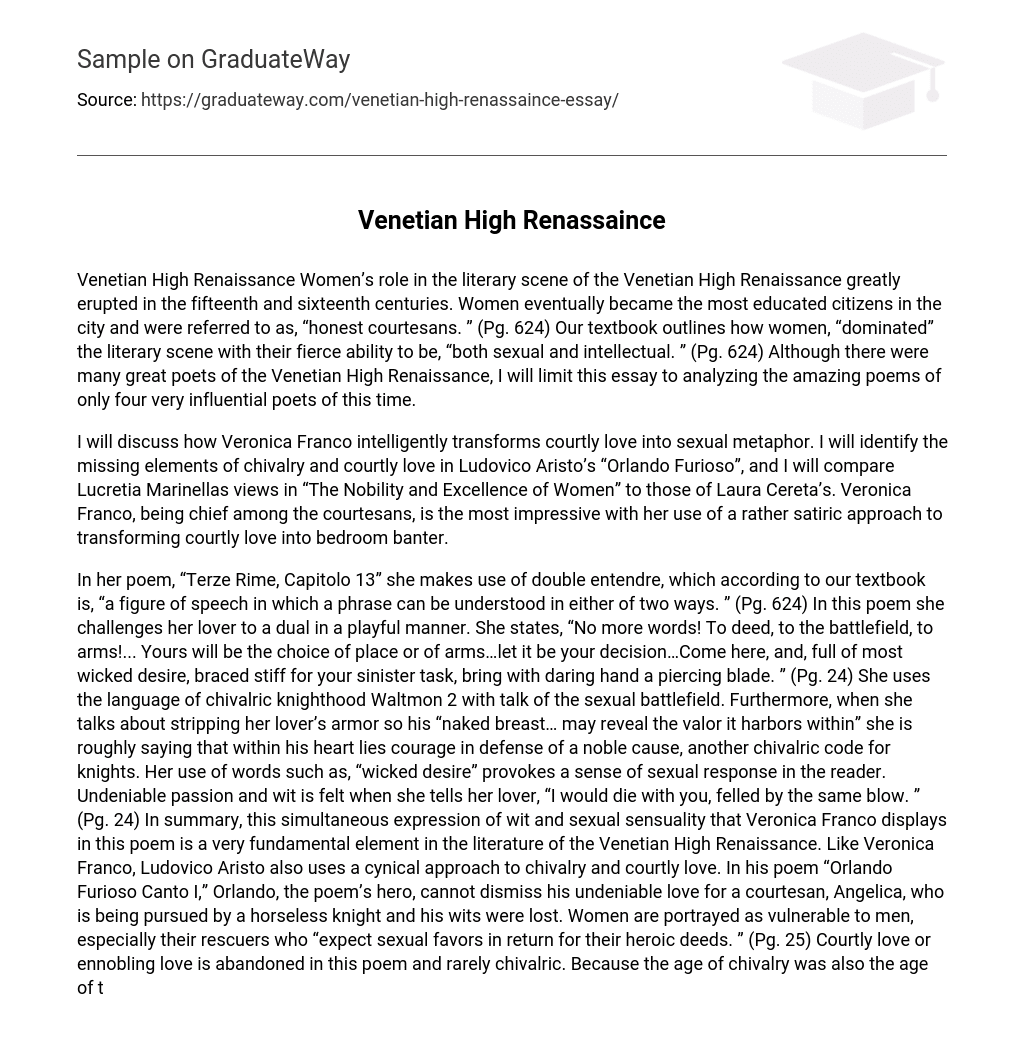Venetian High Renaissance Women’s role in the literary scene of the Venetian High Renaissance greatly erupted in the fifteenth and sixteenth centuries. Women eventually became the most educated citizens in the city and were referred to as, “honest courtesans. ” (Pg. 624) Our textbook outlines how women, “dominated” the literary scene with their fierce ability to be, “both sexual and intellectual. ” (Pg. 624) Although there were many great poets of the Venetian High Renaissance, I will limit this essay to analyzing the amazing poems of only four very influential poets of this time.
I will discuss how Veronica Franco intelligently transforms courtly love into sexual metaphor. I will identify the missing elements of chivalry and courtly love in Ludovico Aristo’s “Orlando Furioso”, and I will compare Lucretia Marinellas views in “The Nobility and Excellence of Women” to those of Laura Cereta’s. Veronica Franco, being chief among the courtesans, is the most impressive with her use of a rather satiric approach to transforming courtly love into bedroom banter.
In her poem, “Terze Rime, Capitolo 13” she makes use of double entendre, which according to our textbook is, “a figure of speech in which a phrase can be understood in either of two ways. ” (Pg. 624) In this poem she challenges her lover to a dual in a playful manner. She states, “No more words! To deed, to the battlefield, to arms!… Yours will be the choice of place or of arms…let it be your decision…Come here, and, full of most wicked desire, braced stiff for your sinister task, bring with daring hand a piercing blade. ” (Pg. 24) She uses the language of chivalric knighthood Waltmon 2 with talk of the sexual battlefield. Furthermore, when she talks about stripping her lover’s armor so his “naked breast… may reveal the valor it harbors within” she is roughly saying that within his heart lies courage in defense of a noble cause, another chivalric code for knights. Her use of words such as, “wicked desire” provokes a sense of sexual response in the reader. Undeniable passion and wit is felt when she tells her lover, “I would die with you, felled by the same blow. ” (Pg. 24) In summary, this simultaneous expression of wit and sexual sensuality that Veronica Franco displays in this poem is a very fundamental element in the literature of the Venetian High Renaissance. Like Veronica Franco, Ludovico Aristo also uses a cynical approach to chivalry and courtly love. In his poem “Orlando Furioso Canto I,” Orlando, the poem’s hero, cannot dismiss his undeniable love for a courtesan, Angelica, who is being pursued by a horseless knight and his wits were lost. Women are portrayed as vulnerable to men, especially their rescuers who “expect sexual favors in return for their heroic deeds. ” (Pg. 25) Courtly love or ennobling love is abandoned in this poem and rarely chivalric. Because the age of chivalry was also the age of the horse, this passage symbolizes the absence of knightly chivalry with the horseless horseman. In the poem’s Canto XI the use of gunpowder is seen as a cowardice alternative to battle. This poem takes away the chivalric codes of knighthood by eliminating the ability of knights’ dexterity in arms with the invention of gunpowder. A great example is when Ariosto states that “the trade of arms become a worthless art: And at such ebb are worth and chivalry, that the base often plays a better part. (Pg. 626) Furthermore, this poem is very skeptical of courtly love and the chivalric code. In her poem, “The Nobility and Excellence of Women and the Defects and vices of Waltmon 3 Men”, Lucretia Martinella counterattacks the spurious chivalric attitudes and behaviors possessed by Renaissance men. She believes that when men put down women, they are purely motivated by anger and envy. In her poem, Martinella talks about how if a man sees a woman as superior to him in any way, he results to torturing himself and is “consumed with envy. (Pg. 626) She explains how men are unable to vent their emotions and the result is them attacking with a “sharp and biting tongue to false and specious vituperation and reproof. ” (Pg. 626) Martinella insists that women are independent and should not be defined only in terms of men. Additionally, Laura Cereta, a very educated poet of the fifteenth century, wrote a poem called the ‘Defense of Liberal Instruction for Women,” which defends her own learning in response to one of her male critics that implied that her father wrote her letters.
She believes in women’s free will in terms of the pursuit of knowledge. She too insisted that women should be allowed the same privileges as men, should they want them and she insists that women should be able to make their own choices. In conclusion, with the growing role of women in the Venetian High Renaissance came a plethora of influential poets including Veronica Franco, who masterly transforms the cliches’ of courtly love into bluntly sexual analogy in her poems.
In addition, the same cynical approach to chivalry and courtly love is used by Ludovico Ariosto in his poem “Orlando Furioso,” in which the elements of chivalry and courtly love are in essence abandoned or falsified. The rise of women’s desire for free will and independence is shown with the works of the great poets Lucretia Marinella and Laura Cereta. The poems discussed throughout this essay are fundamentally important in women’s’ growing role in literature throughout the history of the Venetian High Renaissance.





